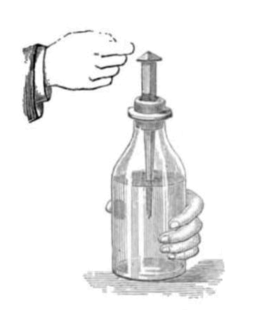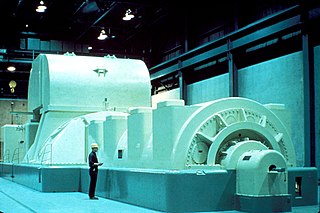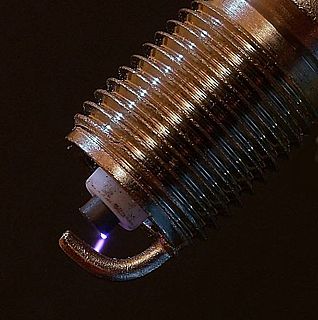
Electricity is the set of physical phenomena associated with the presence and motion of matter that has a property of electric charge. Electricity is related to magnetism, both being part of the phenomenon of electromagnetism, as described by Maxwell's equations. Various common phenomena are related to electricity, including lightning, static electricity, electric heating, electric discharges and many others.

Electric charge is the physical property of matter that causes it to experience a force when placed in an electromagnetic field. There are two types of electric charge: positive and negative. Like charges repel each other and unlike charges attract each other. An object with an absence of net charge is referred to as neutral. Early knowledge of how charged substances interact is now called classical electrodynamics, and is still accurate for problems that do not require consideration of quantum effects.

A Leyden jar is an antique electrical component which stores a high-voltage electric charge between electrical conductors on the inside and outside of a glass jar. It typically consists of a glass jar with metal foil cemented to the inside and the outside surfaces, and a metal terminal projecting vertically through the jar lid to make contact with the inner foil. It was the original form of the capacitor.
Timeline of electromagnetism and classical optics lists, within the history of electromagnetism, the associated theories, technology, and events.
Electrical phenomena are commonplace and unusual events that can be observed and that illuminate the principles of the physics of electricity and are explained by them. Electrical phenomena are a somewhat arbitrary division of electromagnetic phenomena.

Electrostatic discharge (ESD) is the sudden flow of electricity between two electrically charged objects caused by contact, an electrical short, or dielectric breakdown. A buildup of static electricity can be caused by tribocharging or by electrostatic induction. The ESD occurs when differently-charged objects are brought close together or when the dielectric between them breaks down, often creating a visible spark.

In electricity generation, a generator is a device that converts motive power into electrical power for use in an external circuit. Sources of mechanical energy include steam turbines, gas turbines, water turbines, internal combustion engines, wind turbines and even hand cranks. The first electromagnetic generator, the Faraday disk, was invented in 1831 by British scientist Michael Faraday. Generators provide nearly all of the power for electric power grids.

Static electricity is an imbalance of electric charges within or on the surface of a material. The charge remains until it is able to move away by means of an electric current or electrical discharge. Static electricity is named in contrast with current electricity, which flows through wires or other conductors and transmits energy.

Electrostatics is a branch of physics that studies electric charges at rest.

Electrification is the process of powering by electricity and, in many contexts, the introduction of such power by changing over from an earlier power source. The broad meaning of the term, such as in the history of technology, economic history, and economic development, usually applies to a region or national economy. Broadly speaking, electrification was the build-out of the electricity generation and electric power distribution systems that occurred in Britain, the United States, and other now-developed countries from the mid-1880s until around 1950 and is still in progress in rural areas in some developing countries. This included the transition in manufacturing from line shaft and belt drive using steam engines and water power to electric motors.

Electrostatic induction, also known as "electrostatic influence" or simply "influence" in Europe and Latin America, is a redistribution of electric charge in an object, caused by the influence of nearby charges. In the presence of a charged body, an insulated conductor develops a positive charge on one end and a negative charge on the other end. Induction was discovered by British scientist John Canton in 1753 and Swedish professor Johan Carl Wilcke in 1762. Electrostatic generators, such as the Wimshurst machine, the Van de Graaff generator and the electrophorus, use this principle. Due to induction, the electrostatic potential (voltage) is constant at any point throughout a conductor. Electrostatic Induction is also responsible for the attraction of light nonconductive objects, such as balloons, paper or styrofoam scraps, to static electric charges. Electrostatic induction laws apply in dynamic situations as far as the quasistatic approximation is valid. Electrostatic induction should not be confused with Electromagnetic induction.

An electrostatic generator, or electrostatic machine, is an electromechanical generator that produces static electricity, or electricity at high voltage and low continuous current. The knowledge of static electricity dates back to the earliest civilizations, but for millennia it remained merely an interesting and mystifying phenomenon, without a theory to explain its behavior and often confused with magnetism. By the end of the 17th century, researchers had developed practical means of generating electricity by friction, but the development of electrostatic machines did not begin in earnest until the 18th century, when they became fundamental instruments in the studies about the new science of electricity. Electrostatic generators operate by using manual power to transform mechanical work into electric energy. Electrostatic generators develop electrostatic charges of opposite signs rendered to two conductors, using only electric forces, and work by using moving plates, drums, or belts to carry electric charge to a high potential electrode. The charge is generated by one of two methods: either the triboelectric effect (friction) or electrostatic induction.

Live steam is steam under pressure, obtained by heating water in a boiler. The steam is used to operate stationary or moving equipment.
Electrochemistry, a branch of chemistry, went through several changes during its evolution from early principles related to magnets in the early 16th and 17th centuries, to complex theories involving conductivity, electric charge and mathematical methods. The term electrochemistry was used to describe electrical phenomena in the late 19th and 20th centuries. In recent decades, electrochemistry has become an area of current research, including research in batteries and fuel cells, preventing corrosion of metals, the use of electrochemical cells to remove refractory organics and similar contaminants in wastewater electrocoagulation and improving techniques in refining chemicals with electrolysis and electrophoresis.

An electric spark is an abrupt electrical discharge that occurs when a sufficiently high electric field creates an ionized, electrically conductive channel through a normally-insulating medium, often air or other gases or gas mixtures. Michael Faraday described this phenomenon as "the beautiful flash of light attending the discharge of common electricity".

The Dean Single, 3031 Class, or Achilles Class was a type of steam locomotive built by the British Great Western Railway between 1891 and 1899. They were designed by William Dean for passenger work. The first 30 members of the class were built as 2-2-2s of the 3001 Class.

The history of electromagnetic theory begins with ancient measures to understand atmospheric electricity, in particular lightning. People then had little understanding of electricity, and were unable to explain the phenomena. Scientific understanding into the nature of electricity grew throughout the eighteenth and nineteenth centuries through the work of researchers such as Coulomb, Ampère, Faraday and Maxwell.

Faraday's ice pail experiment is a simple electrostatics experiment performed in 1843 by British scientist Michael Faraday that demonstrates the effect of electrostatic induction on a conducting container. For a container, Faraday used a metal pail made to hold ice, which gave the experiment its name. The experiment shows that an electric charge enclosed inside a conducting shell induces an equal charge on the shell, and that in an electrically conducting body, the charge resides entirely on the surface. It also demonstrates the principles behind electromagnetic shielding such as employed in the Faraday cage. The ice pail experiment was the first precise quantitative experiment on electrostatic charge. It is still used today in lecture demonstrations and physics laboratory courses to teach the principles of electrostatics.

Corbett's electrostatic machine is a high voltage static electricity generating device that was made by Thomas Corbett. It was used by Shaker doctors for medical treatment in the early nineteenth century. The machine consisted of a rotating glass jar that produced an electrical charge by means of a crank wheel that was turned by hand. This charge was stored in a glass container that was released later to a patient for a cure. Corbett's machine is in the collection of the Mount Lebanon Shaker Village in the state of New York USA.

Franklin's electrostatic machine is a high-voltage static electricity-generating device used by Benjamin Franklin in the mid-18th century for research into electrical phenomena. Its key components are a glass globe which turned on an axis via a crank, a cloth pad in contact with the spinning globe, a set of metal needles to conduct away the charge developed on the globe by its friction with the pad, and a Leyden jar – a high-voltage capacitor – to accumulate the charge. Franklin's experiments with the machine eventually led to new theories about electricity and inventing the lightning rod.















